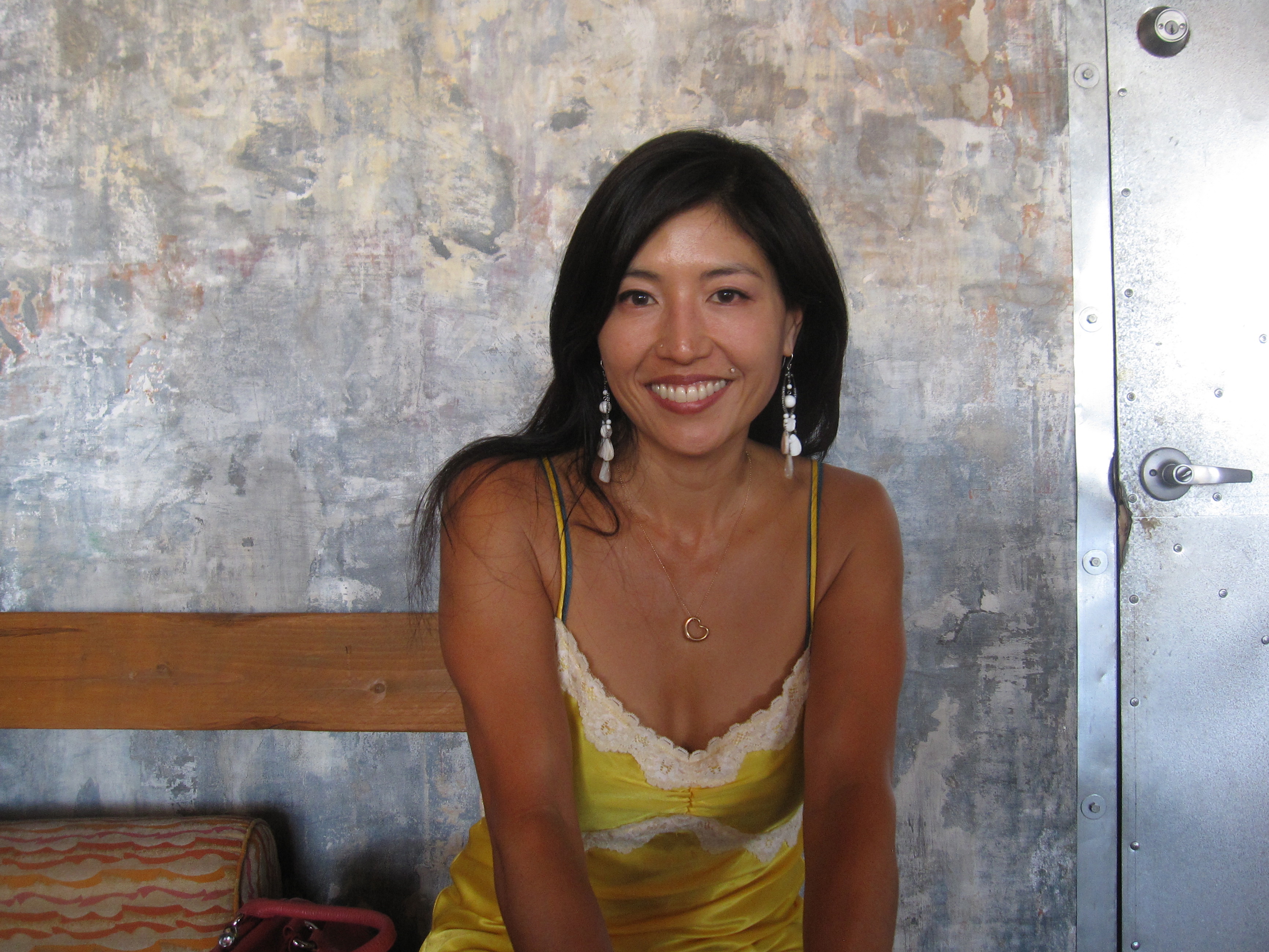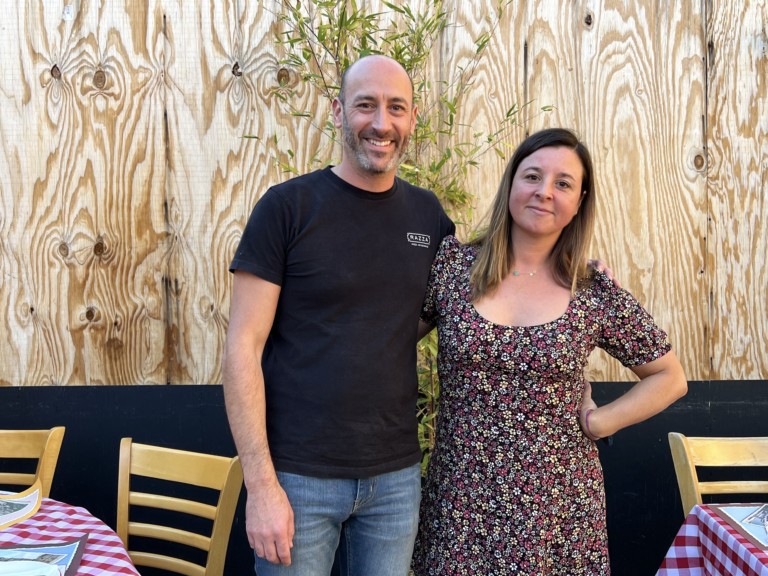INTERVIEW CONTINUED FROM PREVIOUS PAGE
So when you go on hikes, you forage?
Yeah, stinging nettles and fennel.
What’s a recent hike that you went on, and what did you find?
It was right at Pan Pacific Park, across from the Grove. I was foraging pine pollen.
What did you use it for?
I just ate it. Supposedly it’s really good for boosting our immune system. It just tastes like pine, like juniper berries. As the pinecones are coming out, before they become too mature, the ends of it have little yellow powdery pollen, and little nubs. You can just pull it off and eat it. I was trying to capture it into a paper bag, but it was sticking to the paper, so I was just pulling it off and eating it.
Do you drink alcohol?
I do.
What do you enjoy drinking?
Wine and champagne are actually raw, so I enjoy drinking that, but I also drink Scotch, and I drink vodka.
Where do you like to drink them?
I like drinking them at Alex [Reznik]’s restaurant, La Seine. I like going to Playa, because I love the mixologists there. I love going to Sotto. I like all of Bill [Chait]’s restaurants, the Test Kitchen ones. Maybe Penthouse. I’m not really the type to go out drinking much, but sometimes if I meet a friend and we have dinner. Even Chaya. I think I’m going to go to Chaya this week and have a vodka. Cause I feel like lately, I trying to cut back on sugar – even though I’m drinking Chai right now. Vodka has lower sugar than wines, though wines are just juice that have been fermented, so it’s good for probiotics, and it’s raw. I just try to live life in balance and be happy. I used to live really extreme, but not any more.
What’s the latest dish that you developed, and what was your approach?
The latest one that I’m really loving – that I’d probably bring back again – is the cold smoked cashew cheese. I really love that. Also using lapsang souchong to marinate, because in raw food, there’s no heat. That really gave it the flavor because it’s smoked. The smoked cashews, it was hickory, so it gave that it flavor of being cooked, even though it wasn’t. It was cold smoked. Then using the lapsang souchong as a marinade has a really strong smoky flavor, like in mushrooms.
How do you feel about ceviche?
As in raw fish, ceviche? It’s fine. It’s raw. I used to say that if people are going to eat meat, they should eat it raw, but one thing I want to point out is mercury. That’s a really big thing right now. A lot of the sashimi fishes come from larger fish. So if you can make ceviche with shrimp or scallop, or smaller fish like white fish or salmon, I just would watch the mercury levels, because typically, most sashimi fish are high in mercury.
What about beef tartare?
It’s probably better, because the whole idea with raw is there are more enzymes available to help with digestion, and also because we’re not heating it, it’s at a more natural state for our bodies. Bears, out in nature, are out killing things and eating them. Raw, it’s closer to that state than if we heat it, because a bear, let’s say, doesn’t use fire to cook something. It’s just more familiar to our body. But just be careful when you’re doing that. Make sure it’s prepared properly because of e. coli.
What are your favorite outdoor activities?
I run every day. I ride my bike. I love hiking. I love hike-running through the woods and through the canyons. I have a dog, so she keeps me very active outside. Even if I do go to the gym, I ride my bike to the gym. I love roller blading, but I haven’t done it in a little while. I need to get back into it.
What are some techniques that you’re currently experimenting with?
Nobody else is bringing molecular influence to raw food. A lot of what I’ve been doing lately – the smoking and stuff – is sort of molecular. I’ve been studying a lot of molecular gastronomy, which uses chemicals to get certain flavor profiles and textures. If you look at a lot of those chemicals, they come from somewhere in nature, naturally. Sodium alginate is actually kelp. When I did my last dinner at Test Kitchen, I made jellies and stuff, but I would just use kelp. I’d use agar agar instead of the processed chemical. Citric acid comes from lemon juice, so I’d just use lemon juice. When people make their leathers, they seem to make a puree, and boil it with sugar and do all this stuff. All I do is put fruit into a blend, blend it, and then spread it on a dehydrator sheet. I’m eliminating all the processing and just sort of doing it in a healthy whole food way to create new textures. I’m really excited about that. I like playing with that.
What did you learn from your Test Kitchen experience?
I learned a lot. The smoked cashew came out of that. Michael Voltaggio helped me with my menu. Alex Reznik helped me with my menu. Seth Greenberg at Penthouse helped me with my menu. It was just great. I think what I mostly learned at Test Kitchen was community. Prior to Test Kitchen, I hadn’t experienced that before, at least within the raw food microcosm. There can be competition. I have really good friends, and we all seem to share, but we always hear about stories where people are secretive. Food is a trade, it’s an art, so in that way, we have to share and show each other, and teach each other. That way we inspire new ideas. Now Alex has a Kosher restaurant, so he has non dairy things that he learned from me, and he’ll tell you, like his cashew cheese was inspired by the cashew cheese he learned to make from me. Even Haru over at Chaya is inviting me to come and work in his kitchen because he wants to learn some raw techniques. So I think it’s just that cross pollination had been lacking, and that power of that is what I really learned, really being able to have those opportunities, and just being open and sharing. Even with chefs that are more innovative, they’re usually about sharing and inspiring each other, because then we all grow more.
Ani’s Raw Food Asia, what inspired your latest book?
I always have a theme around all my books, so “Ani’s Raw Food Kitchen” was about eco green living. “Ani’s Raw Food Desserts” was about beauty and weight loss, so you can eat raw desserts, but they’ll nutrify your skin with Vitamin E and antioxidants and it will help you lose weight while you’re eating dessert. “Ani’s Raw Food Essentials” was simplifying and breaking down the barriers to entry for raw food, like making dishes with three ingredients, so basic, and then I teach you how to add ingredients to make endless variations. With Asia, it’s funny, but I just started embracing my Asian heritage. As I’ve gotten deeper and deeper into my eco lifestyle, learning more and remembering more about how I was raised, I’m realizing how much of it is part of my culture, reusing things, recycling things, just whole food. I’m watching my cousins raise my nieces and how they make food, and it’s all whole foods. A lot of the kimchis are fermented foods, which are probiotics. Probiotics are really popular right now, because a lot of antibiotics kill our friendly bacteria. Instead of all these probiotic supplements, which are processed products, I’d rather get probiotics from pickled vegetables. That’s all Korean inspired. I sort of realize I’m in this place – being Asian-American – I’ve been straddling East and West, so I can sort of now bring together a fusion of all the best of East and West. That’s what I’m really excited about. There are some benefits that are Eastern living, which is longevity secrets. Seaweed is a longevity secret because it’s so high in minerals, it’s really great at combating heavy metal poisoning, balancing the thyroid. It’s also being used as a treatment for weight loss. Supposedly those minerals can also bring color back into your grey hair. There are these things that we’re looking to the East for, like Chinese medicine, Ayurvedic medicine, yoga and meditation. It’s all come into fashion now in the U.S., which I’m really happy about. I feel like the West has amazing technology, so just being able to fuse the two so there’s that sweet middle ground, I’m really excited about that.









Leave a Comment